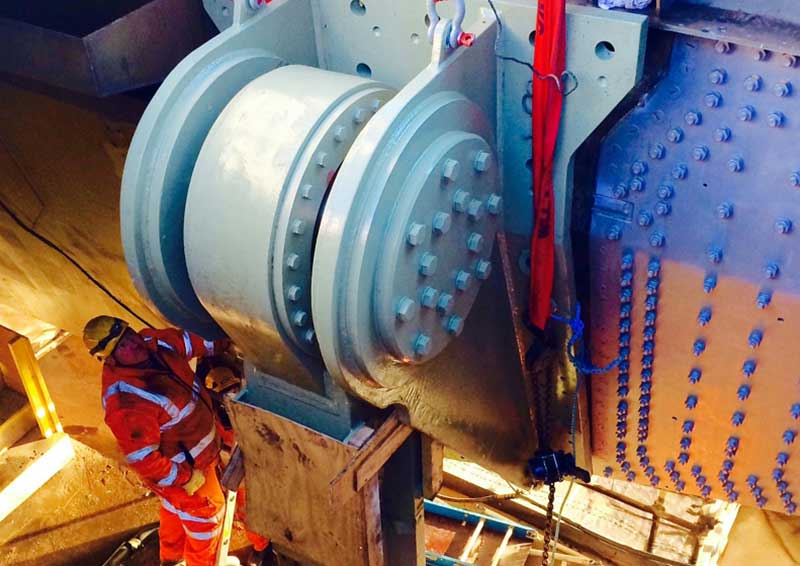Keeping Humber Bridge moving
Prolonging the life of infrastructure saves money and saves the planet – but often not with the cost and significant disruption. Fitting new rocker bearings to the UK’s massive Humber Bridge without stopping traffic shows it can be done.
Britain's 2.2 km long Humber Bridge carries the A15 dual carriageway over the Humber estuary between Hessle in East Yorkshire and Barton in North Lincolnshire. Opened in 1981, its 1,410 m suspended main span it made it the world's longest single-span bridge until 1997 – and it's still in the top 10.
The 4.5 m deep main-span deck box are supported at the suspension towers on four steel A-frame rocker bearings, which carry up to 1,600 tonnes each and allow longitudinal movement of the deck. Routine inspections showed the bearings on these A-frames were wearing prematurely and at risk of seizing.
Following design pioneering by employer and Humber Bridge Board's designer, Arup, it was decided the main span's A-frame rocker bearings should be replaced with an innovative system of vertical pendels and horizontal wind shoes – and that the bridge should remain open to traffic throughout the whole of the works.
The award-winning project, which included fitting temporary pendels to allow the A-frames to be removed, involved threading 1,600 tonnes of specialist steelwork and bearings into a confined environment directly under live traffic and 30 m over water.
Contractor C Spencer Ltd started on site in July 2013 and successfully completed the work exactly two years later. The full story of the challenging project is published in the latest issue (169 CE3) of the Institution of Civil Engineers' journal Civil Engineering.
Project manager Michael Nichols says that despite a well-defined design being prepared prior to tender, the extremely tight constraints on site – including restricted space, the need to keep the bridge open throughout and a number of elements of the existing bridge not being as originally assumed – meant that a collaborative approach was required to resolve the issues encountered.
The contractor was therefore engaged under ICE's collaborative-style NEC3 Engineering and Construction Contract, with Arup retained as NEC project manager and supervisor.
According to Nichols, NEC facilitates a collaborative approach by bringing together the expertise of the contractor and the employer's designer while maintaining clear lines of responsibility. The early warnings process meant outcomes could be managed to minimise costs, enabling a mutually cooperative approach to resolving issues.
"Under NEC, changes to the contract were generally quick and simple to resolve as the contract clearly identifies where risk lies. Generally the process for agreeing compensation events worked well too."
This article was originally published here on 28 July 2016 by ICE. It was written by Simon Fullalove.
--The Institution of Civil Engineers
[edit] Related articles on Designing Buildings Wiki
Featured articles and news
The UK's Modern Industrial Strategy: A 10 year plan
Previous consultation criticism, current key elements and general support with some persisting reservations.
Building Safety Regulator reforms
New roles, new staff and a new fast track service pave the way for a single construction regulator.
Architectural Technologist CPDs and Communications
CIAT CPD… and how you can do it!
Cooling centres and cool spaces
Managing extreme heat in cities by directing the public to places for heat stress relief and water sources.
Winter gardens: A brief history and warm variations
Extending the season with glass in different forms and terms.
Restoring Great Yarmouth's Winter Gardens
Transforming one of the least sustainable constructions imaginable.
Construction Skills Mission Board launch sector drive
Newly formed government and industry collaboration set strategy for recruiting an additional 100,000 construction workers a year.
New Architects Code comes into effect in September 2025
ARB Architects Code of Conduct and Practice available with ongoing consultation regarding guidance.
Welsh Skills Body (Medr) launches ambitious plan
The new skills body brings together funding and regulation of tertiary education and research for the devolved nation.
Paul Gandy FCIOB announced as next CIOB President
Former Tilbury Douglas CEO takes helm.
UK Infrastructure: A 10 Year Strategy. In brief with reactions
With the National Infrastructure and Service Transformation Authority (NISTA).
Ebenezer Howard: inventor of the garden city. Book review.
The Grenfell Tower fire, eight years on
A time to pause and reflect as Dubai tower block fire reported just before anniversary.
Airtightness Topic Guide BSRIA TG 27/2025
Explaining the basics of airtightness, what it is, why it's important, when it's required and how it's carried out.
Construction contract awards hit lowest point of 2025
Plummeting for second consecutive month, intensifying concerns for housing and infrastructure goals.
Understanding Mental Health in the Built Environment 2025
Examining the state of mental health in construction, shedding light on levels of stress, anxiety and depression.























